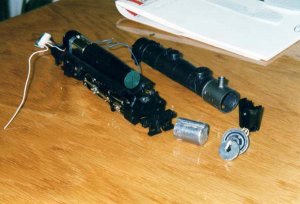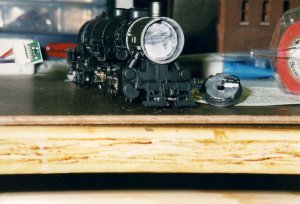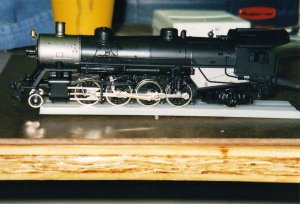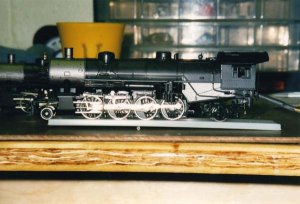Some people have asked for more information on how I added
weight to the Athearn Mikado and Bachmann Consolidation.
In this case, it's fortunate that I'd already
returned the two 2-10-2s to the hobby shop, since I got, in
return, two more Athearn Mikes and another Bachmann 2-8-0.
It was much easier to examine the new locos as an aid in
jogging my memory about the modifications, especially the
2-8-0, since mine are a little more work to disassemble due
to cosmetic modifications.
I weighed the new stock Athearn, loco only: it weighed 12.5
ounces and the balance point was behind the centreline of
the third driver set. In other words, it was back-heavy.
I've heard that some modellers put a stronger spring on the
trailing truck in order to shift some of that imbalance
forward, and this may help. However, I removed the spring
completely (the loco still tracks well) and added weight,
making sure that all of the new weight was placed ahead of
the mid-point of the driver wheelbase (between the 2nd and
3rd drivers).
To balance a loco fairly accurately, you need a balance. I
made one using a sheet of heavy brass and a piece of brass
tubing. Find, by measuring, the mid-point of the brass (you
could use any material, as long as it doesn't flex under the
weight of the loco). Then place the fulcrum (brass tubing
in my case) beneath the sheet at the marked mid-point. You
may have to move the tubing a bit towards either end in
order to get the sheet to balance properly. When it does,
mark it, then solder the tubing to the sheet. It's not
necessary to fasten the fulcrum to the balance if you have
some other way to ensure that it's placed accurately when in
use. If the lead and/or trailing trucks are sprung, they
should be installed when checking the balance, since, as
noted, the springs can shift the balance point. It is
possible that a light loco that is properly balanced will
pull better than an identical, but heavier loco that is not
balanced.
To obtain proper balance of the Athearn Mike, I first
removed the front of the Athearn weight, using a hacksaw
(use masking tape to cover the motor and gears if you don't
completely disassemble the weight.) I made the cut just a
bit in front of the screws that enter each side of the stock
weight, at a point just above the rear half of the front
drivers. These screws attach the front end of the
weight/motor assembly to the chassis and the screw that goes
up into the bottom of the smokebox can be discarded. If you
want working headlights, you're on your own, since I almost
always remove them. To replace the weight just removed, I
used a suitable length of 1/2" copper water pipe, with a
copper cap soldered on one end. I then filled the pipe with
molten lead. You could cram more weight into this space by
making a mould so that the entire weight would be lead, but
this is a quicker solution. I did make moulds, using scrap
aluminum siding (score, cut where required, then bend), to
make two weights that sit on top of the frame in the area
behind the cylinders and in front of the gearbox. These
will pretty much block the view beneath the boiler, but,
unless you use low-mounted floodlamps to light your layout,
this shouldn't be a concern. Paint them black and they'll
disappear. The weights that I cast had to be filed to fit
properly and are held in place by their own weight and the
driver spring castings. Use the normal precautions when
handling lead. Finally, I used a suitably-sized piece of
brass tubing, filled with lead, to create an air reservoir
for the pilot deck, then added the appropriate piping. This
brought the total weight of the loco up to 15 ounces. More
importantly, the weight is balanced at a point mid-way
between the 2nd and 3rd drivers.
The Bachmann 2-8-0, unmodified, weighs 12.75
oz., loco only, but it is balanced around the mid-point of
the driver wheelbase. Some of the weight that I added was
included as part of cosmetic modifications that I made to my
locos, so you might want to skip that step. First, I
removed the lighting, wiring and circuit board for the
headlight and refilled that space with lead. I then
fabricated a new air tank for the pilot, using lead in brass
tubing as with the Athearn. The air reservoirs under the
running boards were similarly replaced, although this
required that the air system be almost completely repiped.
Finally, to put the loco back in balance, a suitable size
block of lead was placed on the cab floor. If you skip the
side air tank replacement, the cab weight should only be
large enough to balance what you actually did add to the
front end. My reballasted Consolidations each weigh 14.25
oz. With both the Athearn and Bachmann locos, use
electrical tape to ensure that the new weights don't cause a
short between the insulated halves of the factory boiler
weights.
When I get around to working on the three recently acquired
locos, I'm going to attempt to find a way to add even more
weight, and I'll report back if I'm successful.
Wayne





